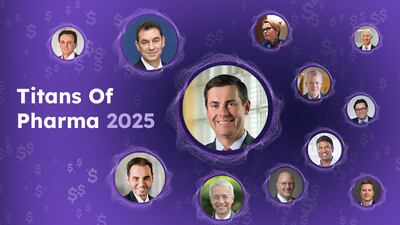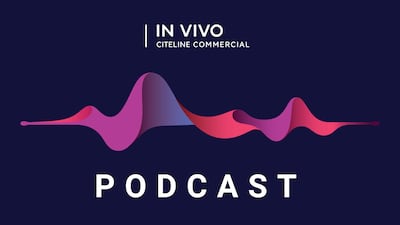Drugs are very much a product of their nurture, rather than nature. This is clearly exemplified when looking at the most valuable assets in the industry today, all of which are the result of extensive investment over a prolonged period of time. Conversely, even the most promising clinical-stage candidate has a ceiling to its commercial potential. To enter the upper echelons and to become a mega-blockbuster, considerable commitment throughout the course of the drug lifecycle is required.
Exhibit 1 cuts across the biopharmaceutical industry by the value of its individual assets, as measured by Evaluate Omnium’s Net Present Value (NPV) Analyzer. To the layperson, NPV is a measure of the value of a drug at a given time point, offsetting future revenues against the costs required to achieve them. To the specialist, NPV is an essential tool to facilitate investment decisions. The myriad factors that underpin its calculation can be the difference between pulling the trigger on a deal, or deciding whether to progress a drug to the next stage of development. Each dot corresponds to an individual drug, and the color coding denotes the maturity of the drug according to first launch year.

Evaluate|Citeline
All Hail King Keytruda
Despite entering its later years, facing the prospect of biosimilar competition and price erosion from 2028, Merck & Co., Inc.'s Keytruda remains the most valuable drug in the industry today. Its NPV stands at a whopping $120bn, which at the time of writing is greater than the total market capitalization of Bristol Myers Squibb Company, the developer of its key competitor Opdivo. Keytruda has become the case study to end all case studies for lifecycle management. Its prescribing information document currently extends to 144 pages, and is growing by the month as new combination and adjuvant trials read out.
Although this analysis is at a single moment in time, it is probable that Keytruda is near its all-time peak valuation. Consensus forecasts suggest that sales will rise to $31bn annually by 2028, on account of its extensive continued development. Furthermore, lifecycle management strategies such as a subcutaneous injection and co-formulations alongside other molecules will further sustain its positioning.
Special Mention To GLP-1s
Bucking the trend for recently launched drugs, GLP-1 agonists are prominent in both the number of high NPV assets a single drug class can sustain, but also the fact that the most recent market entrant occupied the #2 position. At the time of analysis in October 2023, Mounjaro was valued at more than $100bn, despite its market-unlocking obesity approval coming in November (we note that Zepbound’s sales are implied in the Mounjaro number here). Novo Nordisk A/S’s diabetes-approved GLP-1 Ozempic was rated with an NPV of $79bn, ahead of the obesity branded equivalent Wegovy at $57bn. Additional GLP-1 agonists within the top 100 include Rybelsus, Trulicity and CagriSema.
The fact that the NPVs for Mounjaro and Wegovy – where considerable additional clinical development will be concentrated – are not higher reflects two main points. The first is that Eli Lilly and Company and Novo Nordisk will need to invest considerable sums in long-term studies, not to mention manufacturing capabilities, in order to unlock the record-breaking forecasts that Wall Street consensus is suggesting. Furthermore, the forecasts themselves are highly dynamic and it is possible that these two assets will achieve significant upside to their current valuations as new clinical data emerge. Keytruda is likely to be toppled before too long.
Pipeline Drugs Have A Commercial Ceiling
There are just eight drugs within the top 100 that either launched in 2023 or are expected to launch before the end of Evaluate Pharma’s consensus period in 2028. They are all annotated within Exhibit 1, and represent the most attractive assets to emerge from the current industry pipeline. In addition to being less numerous, these R&D-stage drugs also tend towards lower valuations, all possessing an NPV of less than $20bn.
This exemplifies that pivotal clinical data produced during a first approval cycle is only able to support a certain threshold of market potential. Even for clinical breakthroughs such as the beta amyloid antibodies for Alzheimer’s disease, and GlaxoSmithKline’s first-to-market Respiratory Syncytial Virus (RSV) vaccine, broader market adoption will depend upon the generation of longer-term data and real-word clinical familiarity. Such lifecycle management is a critical component of success in the market, both to raise the commercial ceiling, as well as protect revenues from potential competitors.
Notably, three of the leading four R&D-stage drugs as ranked by NPV are part of a lifecycle management strategy themselves. Forecasts and valuations for CagriSema, Eylea HD, and Vyvgart Hytrulo are significantly bolstered by the past successes of their predecessors.
Food For Thought
Does the fact that few of the most valuable assets in the current biopharma portfolio are at an early stage pose a longer-term threat to the industry? What about the financial ability of drug manufacturers to run expensive lifecycle management strategies to unlock higher valuations in light of new legislation? The rules within the Inflation Reduction Act, alongside the European Commission pharmaceutical reform, serve to functionally shorten a drug’s lifecycle and apply pressure on lifecycle management strategies.
Rather than imagining a doomsday scenario, the reality is that portfolio strategies are under constant scrutiny and investment will be reallocated to where there is the greatest return. The status quo that enabled the creation of drugs like Keytruda and Humira may not be present in the future, and the era of mega-blockbusters may be passing. Of course, not before Eli Lilly and Novo Nordisk test the limits of this theory with the huge investments going into the GLP-1 agonist class.








